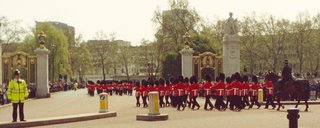I. London Bridge, Tower Bridge
1. In 43 AD, Romans set up a pontoon bridge across the Thames. 1176, Henry II commissioned a stone bridge where a teetering wooden one had been the only means of crossing for centuries. The construction consumed 33 years, but stood for 600 years. It was still inconvenient: a mere one narrow lane north and one narrow land south. That sounds very high, but see
http://www.history.co.uk/study-topics/history-of-london/london-bridge/. Then came a series of collapses,
London Bridge is Falling Down fame. See also
http://www.havasuchamber.com/our-community/london_bridge_history.aspx
2. In 1212, it burned, and 3000 crossers died.
3. In 1825, a new bridge was constructed; followed in 1962 with a bigger, better, wider, new one. The old was packed up to the US, Lake Havasu, Arizona. See the
Havasu Chamber site above. The new bridge is a sleek, sloping non-towered modern affair, see images but specify in a search for London Bridge that 1973 is the pertinent one.
4. London Bridge 1973 is different from Tower Bridge, constructed 1894. Photos often mix the two, calling Tower Bridge by the name London Bridge..
 Tower Bridge, London, England
Tower Bridge, London, England
5. Back to history of crossing the Thames in general. The Thames River used to be about five times as wide as it is now, but shallow so that the tides exposed mud flats. See
http://www.barryoneoff.co.uk/html/london_bridge.html/ A ferry near the bridge site in medieval times offered a choice for passage, and the daughter of the last ferryman, one Mary Ovary sometimes spelled Overy, used her inheritance to build a convent called, yes, St. Mary of the Ovaries, says the site. This was before restrictions on women's inheritance were imposed so the men could get at it came later. As to the Ovaries, clearly we can't have women in such a prominent place, so the men took it over as a college for priests. Plus ca change, and none the better for it, is that so. Perhaps this is a hopeful sign: Cathedral School of St. Saviour and St. Mary Overy, school for children, see
http://www.cathedralprimaryschool.com/
And someone solved the issue: Overy means “over the water” or “over the ferry”, from a Saxon word overie meaning “over the water”. See
https://commonground08.wordpress.com/2010/01/04/st-mary-overy/
6. Battles.
Recalling the bombing of World War II, the Blitz of London, the city
now shows little of that. See photos of the Battle of Britain at
://www.archives.gov/research/ww2/photos/#britain/. Take your own tour
of the remaining sites, and museums commemorating the Blitz, at
://www.citythemes.co.uk/pdffiles/The%20Blitz.pdf
 Buckingham Palace, London, England. Changing of the Guard
Buckingham Palace, London, England. Changing of the Guard
II. Buckingham Palace - the changing of the guard. The palace here is not very old as the Royal Residence. It was bought for that purpose only in 1761. See http://www.royal.gov.uk/TheRoyalResidences/BuckinghamPalace/History.aspx
London Tower. For a virtual tour of London Tower, see www.twingroves.district96.k12.il.us/RenAissance/TowerofLondon/TowerLondon.html/ Find its history at ://www.castles.me.uk/history-of-tower-of-london.htm/ The Normans started it in the 1100's, with a wooden structure, a raised center area with wooden fortifications around -- motte and bailey. It then morphed and developed into a place for state apartments, but also intrigue, defense ongoing, royal refuge, executions, imprisonments.
Our guide said that so many people had been executed there and others were taken there for burial, and all had indeed been buried under the chapel. Finally the stone floor began to heave and buckle and smell so they had to exhume and rebury whoever they could find and identify. Do they still haunt? Ask at ://www.hauntedcastlesandhotels.com/England/tower.htm
Where to sleep in London without giving up your fortune:
Sleeping - Last minute and reasonably priced accommodations can be a problem in the big cities,so aim for the main bus and train stations. Behind Victoria Station in London, for example, is a street that is all little hotels. Fine and clean and convenient.
We drove in all the big cities, on most days preferring the hassle of parking to the blind hurtling of the subways. We like learning the layout ourselves.
 On the way back from Wales - Chester, England, on race day. Hats like pictures of Ascot. Very very. See www.bwpics.co.uk/races.
On the way back from Wales - Chester, England, on race day. Hats like pictures of Ascot. Very very. See www.bwpics.co.uk/races.

 Tower Bridge, London, England
Tower Bridge, London, England Buckingham Palace, London, England. Changing of the Guard
Buckingham Palace, London, England. Changing of the Guard Peter Pan statue, Kensington Gardens, London, England
Peter Pan statue, Kensington Gardens, London, England Leeds Castle, England. Mallard ducks
Leeds Castle, England. Mallard ducks Muscovy Duck, Leeds Castle, England
Muscovy Duck, Leeds Castle, England